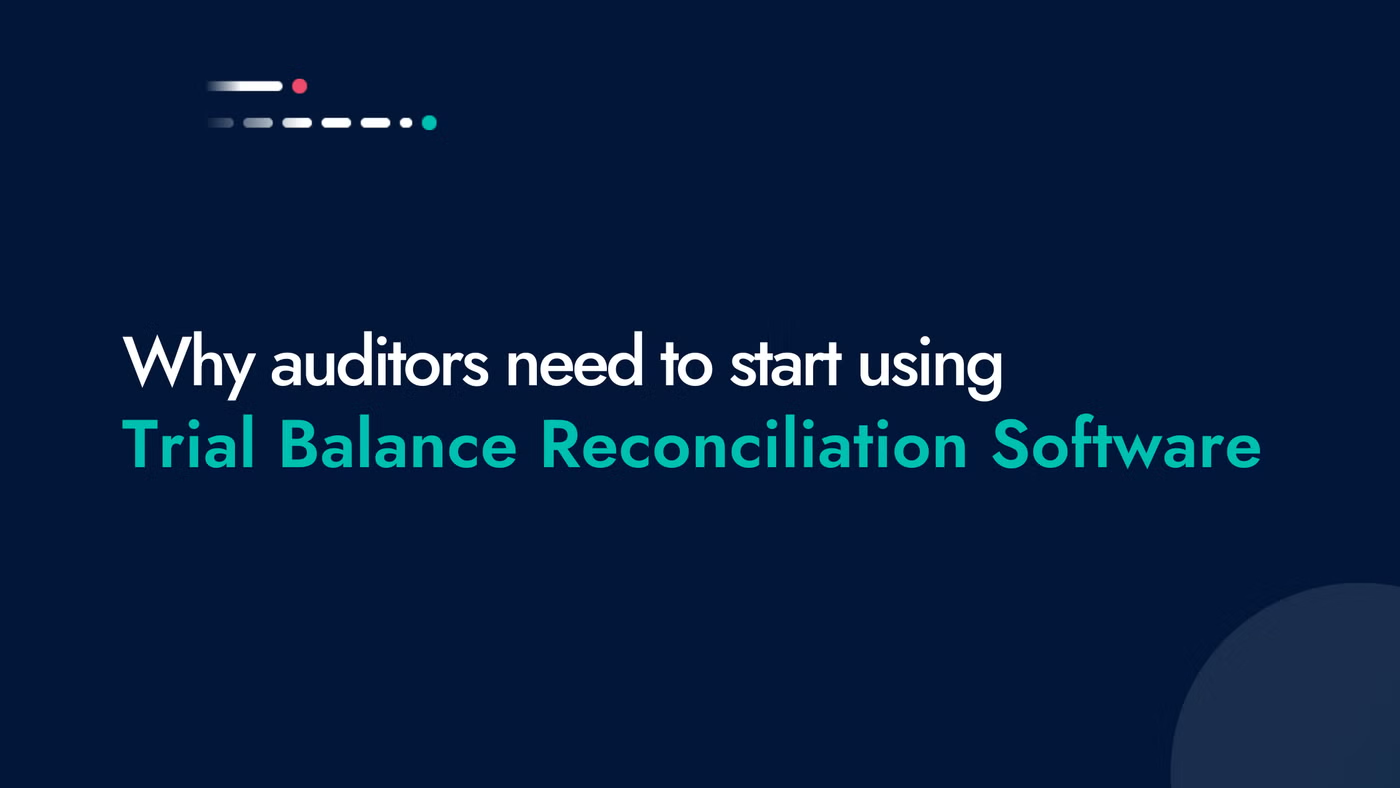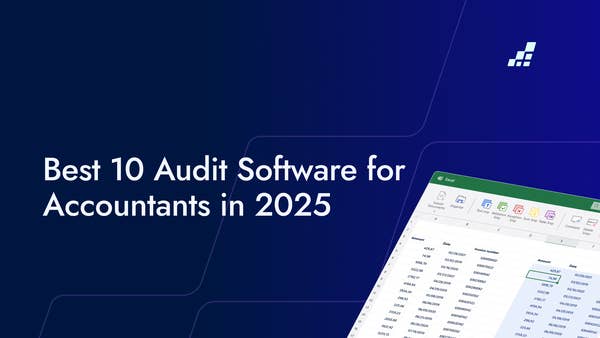- /
- Blog
Why Auditors Need to Start Using Trial Balance Reconciliation Software

As any auditor knows, reconciling trial balances is a crucial component of the auditing process. It's a tedious task that typically involves sifting through vast amounts of financial data to ensure that all accounts are accurate and balanced.
Historically, this has been done manually, a process that can be time-consuming, labor-intensive, and prone to errors.
However, with the advent of trial balance reconciliation software, auditors now have powerful tools that streamline the reconciliation process and deliver a range of benefits.
Understanding Trial Balance Reconciliation
Trial balance reconciliation is the process of making sure that the debit and credits in a company's ledger match and are correct.
This process is critical for ensuring accurate financial reporting, which is essential for businesses to make informed decisions about their finances. Errors in trial balances can lead to inaccurate financial statements, which can result in a host of financial and legal issues.
Auditors play a critical role in reconciling trial balances, as they must identify and resolve any discrepancies to ensure accurate financial reporting.
They use various tools and techniques to ensure that the trial balance is accurate, including automated software programs and manual data entry and examination.
The Importance of Accurate Trial Balances
Accurate trial balances are essential for businesses looking to make informed decisions about their finances.
Without accurate trial balances, errors can go unaddressed, contributing to poor financial reporting, and leading to incorrect conclusions that could impact business decisions.
Accurate trial balances help auditors to give reasonable assurance that the financials of a company are correct.
The Traditional Approach to Trial Balance Reconciliation
Traditionally, auditors use Excel spreadsheets to reconcile trial balances. These spreadsheets can be cumbersome and prone to errors, as they rely on manual data entry and calculations.
With the advent of intelligent automation solutions, however, auditors now have access to more efficient and accurate tools for reconciling trial balances.
These programs can automate many of the manual processes involved in trial balance reconciliation, reducing the risk of errors and improving overall efficiency.
Common Challenges in Manual Reconciliation
Manual reconciliation can lead to a range of challenges for auditors.
- Time-consuming: With manual data entry and examination, auditors can spend hours or even days on reconciliation, taking time away from other critical tasks.
- Errors: Manual reconciliation can lead to errors that are time-consuming to correct, leading to even more delays and frustrations.
- Limited Visibility: Manual reconciliation offers limited visibility into the audit process, making it challenging for auditors to track their progress or identify where errors might be occurring.
Fortunately, intelligent automation can help to address many of these challenges.
By automating much of the reconciliation process, these solutions can reduce the risk of errors and improve overall efficiency, allowing auditors to focus on other critical tasks.
Additionally, they provide greater visibility into the audit process, making it easier for auditors to track their progress and identify any issues that may arise.
Key Features of Trial Balance Reconciliation Software
Trial balance reconciliation software offers a wealth of features that can address many of the challenges traditional approaches to reconciliation face.
Automation and Efficiency
Quick Time Analysis
With trial balance reconciliation software, auditors can quickly analyze data by matching the trial balance figures against the financial statements automatically. This process helps to improve accuracy and minimize the risk of overlooking an error.
Error Detection
Trial balance reconciliation software can flag discrepancies and potential errors automatically. This automated error detection can help auditors focus on more critical and complex tasks rather than spending time on routine tasks such as data entry and basic arithmetic.
Benefits of Implementing Reconciliation Software for Auditors
Time and Cost Savings
Trial balance reconciliation software can help auditors save time and reduce the overall cost of reconciliation.
By automating the process and reducing the risk of errors, auditors can complete the task faster and more efficiently than with manual methods.
Additionally, automating reconciliation frees auditors to focus on more critical aspects of the audit process, such as analysis and judgment.
Improved Audit Quality and Risk Management
Trial balance reconciliation software can help auditors reduce the risk of errors and improve the quality of their audits.
By automating error detection and providing real-time data access, auditors can identify potential issues earlier, allowing them to take corrective action and minimize the risk of financial inaccuracies.
This, in turn, helps to improve risk management for businesses, leading to better decision-making and improved financial performance.
Streamlined Collaboration and Communication
Trial balance reconciliation software can improve collaboration and communication between auditors, their clients, and other stakeholders.
Auditors can easily share data and reports with their clients, providing regular status updates and identifying areas of concern.
Additionally, with customizable reporting and integrations, they can tailor communication to meet the needs of various stakeholders, leading to more effective communication and timely problem resolution.
Scalability and Adaptability
Trial balance reconciliation software is scalable and adaptable to the needs of any business.
The software can be customized to meet the specific requirements of businesses, and it can also integrate with other systems or accounting software.
Additionally, it can handle large amounts of data, making it a suitable solution for businesses of all sizes and industries.
Selecting the Right Trial Balance Reconciliation Software
Assessing Your Firm's Needs and Goals
When selecting trial balance reconciliation software, auditors need to consider their goals, requirements, and the needs of their clients.
Consider things such as the software's required features, compatibility with other systems or software, and the required level of support and training to ensure any software you choose meets your needs.
Evaluating Software Features and Compatibility
Check for features that will suit your specific needs, including reporting, data visualization and automation tools, support for various file formats, etc.
Additionally, ensuring that the software you select is compatible with other systems and software used within your business or client's operations will help ensure that your audit workflows are streamlined and efficient.
Considering Vendor Support and Training
Finally, when selecting trial balance reconciliation software, auditors should consider the quality of vendor support and available training.
Ensure that the vendor provides adequate support throughout the process and that training is comprehensive and easy to understand, which will help ensure that the auditors or users from the client's organization can attain full ROI on the solution.
Trial Balance Reconciliation with DataSnipper
Audit work is typically performed and scoped based on Trial Balance data. However, the sign-off is on the financial statements. This means that a reconciliation between these two sources is almost always required.
A big issue with this is that the trial balance is often provided in an unhelpful, unusable format. It’s usually a large data set that is clunky and cumbersome to work with.
That’s where DataSnipper steps in. Auditors using DataSnipper:
- Extract the Trial Balance data into a usable format utilizing the table snip function.
- Create a pivot table in Excel to summarize.
- Then use Document Matching to reconcile the summarized Trial Balance data in the financial statements and ensure that the balance included in the final financial statements is accurate per the trial balance.
Curious to see this in action? Check out our Use Case video below.
FAQs
Why do we need to do balance sheet reconciliation?
Balance sheet reconciliation is vital for ensuring accurate financial statements, detecting errors, preventing fraud, meeting regulatory requirements, and fostering trust in financial reporting, ultimately supporting informed decision-making.


